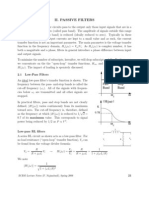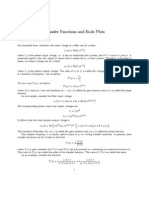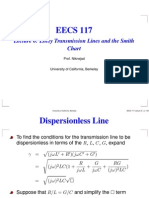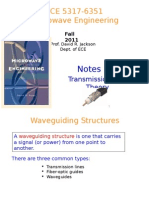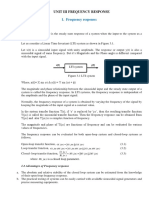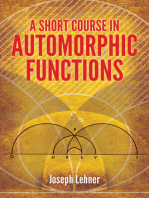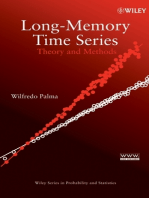Ee122 Freq Resp Revnotes
Ee122 Freq Resp Revnotes
Uploaded by
Micro EmissionCopyright:
Available Formats
Ee122 Freq Resp Revnotes
Ee122 Freq Resp Revnotes
Uploaded by
Micro EmissionOriginal Description:
Copyright
Available Formats
Share this document
Did you find this document useful?
Is this content inappropriate?
Copyright:
Available Formats
Ee122 Freq Resp Revnotes
Ee122 Freq Resp Revnotes
Uploaded by
Micro EmissionCopyright:
Available Formats
EE122: Frequency Response of Passive Circuits
Review Notes on the Frequency Response
of Passive Circuits
Prepared by Rizwan Ahmed
Stanford University
January 7, 2003
1 Impedance of Resistors, Capacitors, and Inductors
We write the impedance of a component as Z and the frequency as . Then the impedance of a resistor is
Z
R
= R, The impedance of a capacitor is Z
C
= 1/(jC), and the impedance of an inductor is Z
L
= jL.
Thus a capacitor is a short circuit (Z
C
= 0) at high frequencies and is an open circuit (Z
C
= ) at DC.
An inductor is an open circuit (Z
L
= ) at high frequencies and is a short circuit (Z
L
= 0) at DC. To
understand how we arrive at these equations, recall that inductors store energy with magnetic elds where
as capacitors store energy with electric elds. Using these impedances we can do frequency analysis of our
circuit using normal methods (KVL, KCL, Ohms Law, etc . . .). The input/output relationship is referred
to as the Transfer function, and is often denoted as H(j). At any given frequency, this is just a complex
number. The magnitude and phase of this number give the magnitude and phase of the output in relation
to the input.
2 Identifying the Frequency Response Visually
Good circuit designers can just look at a complex circuit and start identifying components (ampliers, lters,
etc . . . ). Identify the frequency response (Lowpass, Highpass, or Bandpass) of the circuits in the gure below.
R
1
R
2 L
C
R
R
1
C L
R
2
V
out V
out
V
out
hint: Think about how the circuits would behave at DC and very high frequencies.
3 Dening the Cuto Frequency
The cuto frequency is dened where
P
out
(
c
) =
P
max
2
(1)
Plugging in the denition of power across a resistor, we obtain the equation
V
2
(
c
)
R
=
V
2
max
2R
(2)
which leads to
V (
c
)
V
max
=
1
2
(3)
1
EE122: Frequency Response of Passive Circuits
So the ratio of the transfer function is equal to 1/
2 at the cuto frequency.
The decibel is a convenient unit when measuring values over a very wide range and is often used in en-
gineering. If the measurement is voltage, the value in decibels is dened as
V
dB
= 20 log([V [) (4)
plugging in equation (3) we get
V
dB
(
c
) = 20 log
[V
max
[
= 20 log([V
max
[) 20 log(
2)
V
dB
(
c
) = V
dBmax
3dB (5)
So the voltage is 3dB down at the cuto frequency! In the case of power measurements, the value in
decibels is dened as
P
dB
= 10 log(P) (6)
plugging in equation (1) we get
P
dB
(
c
) = 10 log(
P
max
2
) = 10 log(P
max
) 10 log(2)
P
dB
(
c
) = P
dBmax
3dB (7)
So the power is 3dB down at the cuto frequency as well.
4 Bode Plots
Before digital computers were a commonplace, a quick way of sketching the frequency response of a system
was the Bode plot. However, these plots still provide valuable intuition and insight and thus remain an im-
portant concept. The Bode plot is a piecewise linear approximation of the transfer function (both magnitude
and phase) that can be constructed using a set of simple rules. To construct a Bode plot, we must write
the transfer function in the following form (known as the standard form). The z and p terms are called the
zeros and poles respectively.
H(j) = k
(j)
(1
j
z
1
)(1
j
z
2
) (1
j
z
m
)
(1
j
p
1
)(1
j
p
2
) (1
j
p
n
)
(8)
Now if we measure the transfer function in decibels and use the properties of logarithms (multiplication
addition, division subtraction, exponents coecients), we obtain
H(j)
dB
= 20 log([k[) 20 log() + 20 log
1
j
z
1
+ 20 log
1
j
z
m
(9)
20 log
1
j
p
1
20 log
1
j
p
n
The rst term is a constant and the second is linear on a log scale. The other terms are approximated in the
following way. If z than 1
z
1 and 20 log(1) = 0. On the other hand, if z than [1
z
[
z
and
20 log(/z) is a linear term on a log scale. We approximate these terms on the Bode plot by letting them
equal zero until = z and linear afterwards. Of course, this reasoning also holds for the poles. So here are
the rules to making a Bode plot.
1. Construct a log-log plot with on the x-axis and [H(j)[dB on the y-axis. Let the x-axis start at 1.
2. Calculate 20 log([k[), this is the starting point on the y-axis at = 1.
3. If you have a linear term, then start rising by 20dB/decade. If not, then stay constant. Do this until
you encounter a pole or zero.
2
EE122: Frequency Response of Passive Circuits
4. If you encounter a pole, start dropping by 20dB/decade. If you encounter a zero, start rising by
20dB/decade.
5. The rises and drops are cumulative. So for example, if you have a linear term with = 2 and two poles
at = 1000Hz, you would rise at 40dB/decade and atten out after = 1000Hz (This is a second
order high-pass lter).
Now if we look at the phase, we use two very convenient properties of the phase of complex numbers; namely
that multiplication addition and division subtraction. So the phase of the transfer function is given by
H(j) =
k +
(j)
1
j
z
1
1
j
z
m
1
j
p
1
1
j
p
n
(10)
The phase of the rst term is 0 if k 0 and 180
otherwise. The second term has a phase of 90
. The
phase of the pole and zero terms is approximated in the following way. If z than 1
j
z
1 and
1 = 0.
If = z than
1
j
z
= 45
. Finally if z than 1
j
z
j
z
and
j
z
= 90
(all of this
assumes a positive z). Here are the rules for constructing a phase Bode plot.
1. Construct a semilog plot with on the x-axis and
H(j) on the y-axis. Let the x-axis start at 1.
2. Calculate
k +
(j)
. This is the starting point of your phase plot.
3. If you encounter a pole, construct a linear drop of 90
from 0.1z to 10z. If you encounter a negative
zero ('z < 0), construct a linear rise of 90
from 0.1z to 10z. If you encounter a positive zero
('z > 0), construct a linear drop of 90
from 0.1z to 10z.
If the steps sound a bit confusing, it is only because it is dicult to put them into words. The actual steps
are very straightforward. Constructing Bode plots becomes much clearer after doing a few examples.
5 Some Common Filters
You will all use lters in your projects. The forms for some common transfer functions is given below.
A lowpass lter with a given
c
and a rollo of n 20dB/decade. H(0) is the DC gain and n is the
order of the lter.
H(j) =
1
(1 +
j
c
)
n
H(0) (11)
A highpass lter with a given
c
and a rollo of n 20dB/decade. H() is the gain at innite frequency
and n is the order of the lter.
H(j) =
1 +
j
n
H() (12)
A bandpass lter with 20dB/decade rollo in both directions. is the bandwidth (the amount of
spectrum between the 3dB points) and H(
o
) is the transfer function evaluated at the center frequency
of the passband. While we did not put this in standard form it is easy to see that it has a linear term
and two poles. Thus it will rise and then eventually fall at 20dB/decade. With some algebraic eort,
you can show that the and
o
are indeed the bandwidth and center frequency respectively.
H(j) =
j
(j)
2
+(j) +
2
o
H(
o
) (13)
It is easy to realize these transfer functions with circuits. The importance of writing the transfer function
in these forms is that they give an easy way of identifying the important parameters of the lter (cuto
frequency in the case of LP and HP lters, and center frequency and bandwidth in the case of the BP lter).
3
EE122: Frequency Response of Passive Circuits
6 Examples
Example 1
R
L
Type of Filter
V
out
V
in
First, we see that this circuit is a voltage divider. So we write
H(j) =
R
R +jL
(14)
or in standard form
H(j) =
1
1 +j/(R/L)
(15)
So we can immediately see that the cuto frequency is
c
= R/L. The magnitude and phase of the transfer
function is given by
[H(j)[ =
1
1 + (
L
R
)
2
(16)
H(j) =
1
1 +
j
R/L
(17)
We can simplify the equation for the phase to get
H(j) = tan
1
L
R
(18)
The gure below plots the true magnitude and phase response (blue) and the Bode approximations (red).
Example 2
R
2
Type of Filter
V
in
R
1
V
out
L
We see that the impedance of R
2
| L is
jLR
2
R
2
+jL
. So we write
H(j) =
jLR
2
R
2
+jL
R
1
+
jLR
2
R
2
+jL
(19)
4
EE122: Frequency Response of Passive Circuits
Doing some algebra, we get
H(j) =
R
2
R
1
+R
2
(j)/(R
1
R
2
/L(R
1
+R
2
))
1 + (j)/(R
1
R
2
/L(R
1
+R
2
))
(20)
Comparing with the standard form of the highpass lter we see that, H() =
R
2
R
1
+R
2
and
c
=
R
1
R
2
L(R
1
+R
2
)
.
Now suppose R
2
R
1
and R
1
= 100, and you need a
c
= 1kHz. What value would you choose for
the inductor?
Since R
2
R
1
, we can ignore R
1
in the denominator of the expression for the cuto frequency. Then
R
2
s cancel and we are left with
c
= R
1
/L. Thus L = R
1
/
c
= R
1
/(2f
c
). Then,
L =
100
2 1000Hz
=
1
20
H 15.9 mH (21)
The gure below plots the true magnitude and phase response (blue) and the Bode approximations (red).
Example 3
R
Type of Filter
V
in
V
out
C L
We write the transfer function
H() =
R
R +jL + 1/(jC)
(22)
or equivalently as
H() =
j(R/L)
j
2
2
+j(R/L) + 1/(LC)
(23)
so
o
= 1/
LC and = R/L. We also calculate the magnitude and phase of the transfer function.
[H(j)[ =
(R/L)
(
R
L
)
2
+ (
1
LC
2
)
2
(24)
H(j) =
(j(R/L))
1
LC
2
+j(R/L)
(25)
This simplies down to
H(j) = 90
tan
1
(R/L)
1/(LC)
2
(26)
The next gure plots the true magnitude and phase response.
5
EE122: Frequency Response of Passive Circuits
6
You might also like
- Lab 8Document8 pagesLab 8alif fudenNo ratings yet
- LAB10Document8 pagesLAB10Juan Camilo Guarnizo Bermudez100% (1)
- MIT Lockpicking GuideDocument49 pagesMIT Lockpicking GuideNarrowPathPilgrim100% (10)
- RCA BA-73C Instructions Masuto'sDocument16 pagesRCA BA-73C Instructions Masuto'sMasuto MasuNo ratings yet
- FilterDocument21 pagesFilterarjun sharmaNo ratings yet
- Chapter 12 Bode PlotsDocument39 pagesChapter 12 Bode PlotsMayar Magdy MorkosNo ratings yet
- Ii. Passive Filters: V o I VDocument21 pagesIi. Passive Filters: V o I VĐỗ Quang ViệtNo ratings yet
- S Domain AnalysisDocument9 pagesS Domain Analysisfaisal140No ratings yet
- Very Good Bode Plot TutorialDocument5 pagesVery Good Bode Plot TutorialsukusportyNo ratings yet
- End TermDocument12 pagesEnd TermCarmela Elaco VillanuevaNo ratings yet
- L #1: T F R S C: Sfsu - E 301 - E L AB Ime and Requency Esponses of Eries IrcuitsDocument8 pagesL #1: T F R S C: Sfsu - E 301 - E L AB Ime and Requency Esponses of Eries IrcuitsRudra MishraNo ratings yet
- Chapter 5 EditDocument65 pagesChapter 5 EditR Loghanyah M.RameshNo ratings yet
- 2labman lcr7Document8 pages2labman lcr7RufosNo ratings yet
- Frequency Response and Bode Plots: 1.1 PreliminariesDocument20 pagesFrequency Response and Bode Plots: 1.1 PreliminariesAmresh VarshneyNo ratings yet
- Experiment # 05: ObjectiveDocument16 pagesExperiment # 05: ObjectiveAbdul MoeezNo ratings yet
- Experiment # 1: Time and Frequency Responses of Series RLC CircuitsDocument6 pagesExperiment # 1: Time and Frequency Responses of Series RLC CircuitsJhonn HuamFloNo ratings yet
- Module 4-ICSDocument188 pagesModule 4-ICShokohad413No ratings yet
- Filters 2Document60 pagesFilters 2Nguyễn Hoàng KhaNo ratings yet
- 14.4 Bode Plots: Frequency Response 589Document12 pages14.4 Bode Plots: Frequency Response 589Luis Lizana100% (1)
- Transfer Functions and Bode PlotsDocument8 pagesTransfer Functions and Bode PlotsChakravarthi VakalapudiNo ratings yet
- Power System Analysis: Transmission Line ModelsDocument33 pagesPower System Analysis: Transmission Line Modelsmohon_eee03No ratings yet
- S2A Transfer Functions RLC and Filters v3BDocument78 pagesS2A Transfer Functions RLC and Filters v3BRamenKing12No ratings yet
- Eca 2 Frequency ResponseDocument37 pagesEca 2 Frequency ResponseHassan Aamer100% (1)
- E11 Lab 6Document15 pagesE11 Lab 6marcosscaratoNo ratings yet
- Modelling of LinesDocument31 pagesModelling of Linesdwarakesh14No ratings yet
- Notes On Chebyshev Filters PDFDocument12 pagesNotes On Chebyshev Filters PDFArchit JainNo ratings yet
- Bode PlotDocument30 pagesBode Plotrokred18No ratings yet
- Filters2 PDFDocument60 pagesFilters2 PDFTuấnNguyễnNo ratings yet
- CH 09Document66 pagesCH 09Praveen Kumar Kilaparthi0% (1)
- Outline of Solutions To Homework 5Document5 pagesOutline of Solutions To Homework 5Jordan MoshcovitisNo ratings yet
- Filter PDFDocument15 pagesFilter PDFHussain RizviNo ratings yet
- Two-Port Parameters For Single-Stage Amplifiers: R R G R RDocument8 pagesTwo-Port Parameters For Single-Stage Amplifiers: R R G R RduefeNo ratings yet
- Lecture 6 Lossy Transmission Lines and The Smith ChartDocument33 pagesLecture 6 Lossy Transmission Lines and The Smith Chartvaldesc_tolNo ratings yet
- Chapter 7Document23 pagesChapter 7lulubeingcrayNo ratings yet
- Notes 1 - Transmission Line TheoryDocument82 pagesNotes 1 - Transmission Line TheoryMaraMendozaNo ratings yet
- CHAPTER 2 - Ac Circuits - Part 1Document23 pagesCHAPTER 2 - Ac Circuits - Part 1muhammad irfan hakimi bin nor yazidNo ratings yet
- Bode Plots (Note) PDFDocument5 pagesBode Plots (Note) PDFTejaswi J DamerlaNo ratings yet
- Transmission Lines and Matching: For High-Frequency Circuit Design ElectiveDocument28 pagesTransmission Lines and Matching: For High-Frequency Circuit Design ElectiveBrij Mohan SinghNo ratings yet
- Power System Analysis: Transmission Line ModelsDocument33 pagesPower System Analysis: Transmission Line ModelsShuhan Mohammad Ariful HoqueNo ratings yet
- Transmission Line: Prof. M M SharmaDocument28 pagesTransmission Line: Prof. M M SharmaJaiverdhanNo ratings yet
- Lecture-4-part 2-ECD-DE44Document15 pagesLecture-4-part 2-ECD-DE44tanveer1111110No ratings yet
- Frequency ResponseDocument28 pagesFrequency ResponseJalu PrasetyoNo ratings yet
- Lecture6 PDFDocument33 pagesLecture6 PDFaminNo ratings yet
- ENTC 3320: Active FiltersDocument60 pagesENTC 3320: Active FiltersAbdullah NisarNo ratings yet
- Lecture 5Document34 pagesLecture 5Aditya ChauhanNo ratings yet
- Tushar Taru - Logbook - Power Electronics - 2021Document14 pagesTushar Taru - Logbook - Power Electronics - 2021Tushar TaruNo ratings yet
- 333 Answers 2009 10 Q1 FinalDocument3 pages333 Answers 2009 10 Q1 Finalaku011987No ratings yet
- Chap 14Document108 pagesChap 14japanphoto323No ratings yet
- ELEC 1A 5-CorrDocument6 pagesELEC 1A 5-CorrdajeanbertinNo ratings yet
- DynamixDocument61 pagesDynamixtrko5354No ratings yet
- Unit Iii Frequency ResponseDocument28 pagesUnit Iii Frequency ResponseRaghu RamNo ratings yet
- Bode Plot UpdatedDocument43 pagesBode Plot UpdatedBen TinNo ratings yet
- PE - Logbook - Tushar TaruDocument14 pagesPE - Logbook - Tushar TaruTushar TaruNo ratings yet
- Frequency Domain AnalysisDocument41 pagesFrequency Domain AnalysisgwemeowenNo ratings yet
- 09 - Chapter 1Document16 pages09 - Chapter 1Shaik KareemullaNo ratings yet
- Ca Array 9 16Document8 pagesCa Array 9 16Manjunath RamachandraNo ratings yet
- Green's Function Estimates for Lattice Schrödinger Operators and ApplicationsFrom EverandGreen's Function Estimates for Lattice Schrödinger Operators and ApplicationsNo ratings yet
- Feynman Lectures Simplified 2C: Electromagnetism: in Relativity & in Dense MatterFrom EverandFeynman Lectures Simplified 2C: Electromagnetism: in Relativity & in Dense MatterNo ratings yet
- 8 Additional MaterialsDocument32 pages8 Additional MaterialsMicro EmissionNo ratings yet
- ECET 105 Week 7 Lab Project Detailed DirectionsDocument14 pagesECET 105 Week 7 Lab Project Detailed DirectionsMicro EmissionNo ratings yet
- Capacitors Demystified Ee133Document6 pagesCapacitors Demystified Ee133Micro EmissionNo ratings yet
- Courseinfo OldDocument12 pagesCourseinfo OldMicro EmissionNo ratings yet
- Creating Custom MOSFETs With MultisimDocument5 pagesCreating Custom MOSFETs With MultisimMicro EmissionNo ratings yet
- RA-5700 Tri-Band Distributed Antenna System: User ManualDocument66 pagesRA-5700 Tri-Band Distributed Antenna System: User ManualforwirelessNo ratings yet
- 439DEX - Hazardous Location BellsDocument2 pages439DEX - Hazardous Location BellsDauXuan HuynhNo ratings yet
- RF Test Antennas Catalog Selection Guides enDocument27 pagesRF Test Antennas Catalog Selection Guides enFrancisco RomanoNo ratings yet
- Alliance Distributor RFS Microwave Antenna SB1-127CBDocument2 pagesAlliance Distributor RFS Microwave Antenna SB1-127CBCarlos Ypanaque VillaltaNo ratings yet
- 80010668Document2 pages80010668Marco MendesNo ratings yet
- Zal1 - Słownik AkustycznyDocument62 pagesZal1 - Słownik AkustycznyKate IdzikowskaNo ratings yet
- Lecture01 IntroductionDocument48 pagesLecture01 Introductionstephen562001No ratings yet
- 1AT3 Microwave Communications and Satellite CommunicationsDocument1 page1AT3 Microwave Communications and Satellite CommunicationsNicholson ZapantaNo ratings yet
- Ch7 Digital Transmission Systems - 2Document17 pagesCh7 Digital Transmission Systems - 2Krishna Prasad PheluNo ratings yet
- The Neumann KH Line. The Neumann KH Line.: Studio Monitor SystemsDocument36 pagesThe Neumann KH Line. The Neumann KH Line.: Studio Monitor SystemsRo HenNo ratings yet
- FSH Z14 ServiceManual en v1Document26 pagesFSH Z14 ServiceManual en v1Luis Quito CespedesNo ratings yet
- Science 117 - SG 2 Sound and HearingDocument16 pagesScience 117 - SG 2 Sound and HearingDen Angelica DungoNo ratings yet
- Reconfigurable AntennasDocument74 pagesReconfigurable Antennassasinnn100% (1)
- SM PDF Chapter14 PDFDocument37 pagesSM PDF Chapter14 PDFsuryapmohantyNo ratings yet
- 3A524-UL Je Naš Početni Model Serije Torusnih Push-Pull IzlaznihDocument3 pages3A524-UL Je Naš Početni Model Serije Torusnih Push-Pull IzlaznihIvan MojsaNo ratings yet
- UT PCN NotesDocument129 pagesUT PCN Notesshahid khanNo ratings yet
- Nokia VS Ericsson PDFDocument64 pagesNokia VS Ericsson PDFTsu Wan Di I75% (4)
- T Rec G.651 198811 S!!PDF eDocument34 pagesT Rec G.651 198811 S!!PDF eFrancisco Medina RiveraNo ratings yet
- Virtual Reconstruction of The Historical Acoustics of The Odeon of PompeiiDocument13 pagesVirtual Reconstruction of The Historical Acoustics of The Odeon of PompeiiDaniel CastroNo ratings yet
- Cma BDHL 6520-21 E0-6 A2-4g PDFDocument1 pageCma BDHL 6520-21 E0-6 A2-4g PDFDo Ngoc AnhNo ratings yet
- (BS EN 61746 - 2001) - Calibration of Optical Time-Domain ReflectometersDocument70 pages(BS EN 61746 - 2001) - Calibration of Optical Time-Domain ReflectometersИРадојичићNo ratings yet
- Chap3 LRUDescriptionsDocument46 pagesChap3 LRUDescriptionsErichCastrejónRodriguezNo ratings yet
- FWM2200XDocument30 pagesFWM2200XValdir KoxinhaprNo ratings yet
- hmc406 Ic PA Cua TS832Document8 pageshmc406 Ic PA Cua TS832triNo ratings yet
- Bizhub Install GuideDocument31 pagesBizhub Install Guideperseidas2No ratings yet
- Detection of Incipient Faults in DistributionDocument9 pagesDetection of Incipient Faults in DistributionSahiba MirzaNo ratings yet
- CS7276788 - 01 T0030MXV011Document2 pagesCS7276788 - 01 T0030MXV011budi wirahmiNo ratings yet
- SLM (Acoustics)Document8 pagesSLM (Acoustics)Afiq BahaNo ratings yet
- ICEpower50ASX2 Datasheet 1 8Document34 pagesICEpower50ASX2 Datasheet 1 8GaouldNo ratings yet






